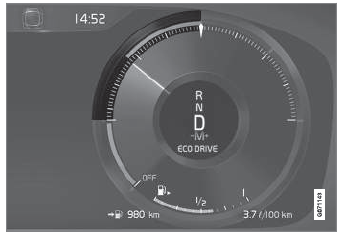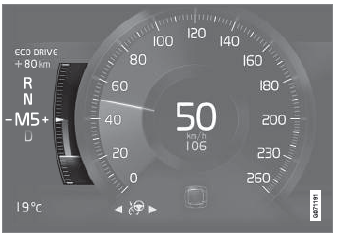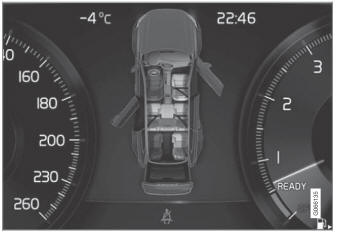Volvo XC90: Starting and driving / Eco drive mode
Eco drive mode can help make driving more fuel-efficient and eco-friendly. Use this mode to save fuel and promote ecofriendly driving.
When Eco mode is activated, the following characteristics are modified:
- The automatic transmission's shifting points.
- Engine control and accelerator pedal response.
- Eco Coast functionality is activated and engine braking is disabled when the accelerator pedal is released at speeds between 65 and 140 km/h (40 and 87 mph).
- Some of the climate system settings will be reduced or switched off.
- The suspension's self-leveling function* will lower ground clearance to help reduce wind resistance.
- Information will be shown in the ECO gauge in the instrument panel to help promote more eco-friendly and economical driving.
Coast function Eco Coast
Eco Coast essentially deactivates engine braking, allowing the vehicle's kinetic energy to be used to roll greater distances. When the driver releases the accelerator pedal, the transmission is automatically disengaged from the engine. Engine speed is reduced to idling speed to reduce fuel consumption.
This function is most effective in driving situations where the vehicle can roll freely for a long distance e.g. on roads with slight downgrades or when a decrease in speed is anticipated such as when approaching an area with a lower speed limit.
Activating Eco Coast
The function is activated when the accelerator pedal is fully released and the following conditions are met:
- Eco drive mode is activated.
- The gear selector is in D.
- The vehicle's speed is approximately 65-140 km/h (40-87 mph).
- The gradient of the downgrade is less than approximately 6%.
COASTING will be displayed in the instrument panel when Eco Coast is being used.
Limitations
Eco Coast is not available if
- the engine and/or transmission are not at normal working temperatures
- the gear selector is moved from D to manual shifting mode
- the vehicle's speed is not within the 65-140 km/h (40-87 mph) range
- the gradient of the downgrade is more than approximately 6%
- the steering wheel paddles* are being used for manual shifting.
Deactivating and turning off Eco Coast
In certain situations, it may be advisable to deactivate or turn off Eco Coast so that engine braking can be used. These situations might include driving down steep hills or before passing another vehicle to help ensure this can be done as safely as possible.
Deactivate Eco Coast by
- pressing the accelerator or brake pedal
- moving the gear selector to manual mode
- using the steering wheel paddles* to shift. Turn off Eco Coast by
- switching to another drive mode*
- deactivating Eco drive mode in Function view.
It is possible to roll short distances even without Eco Coast in order to help conserve fuel. However, for the best fuel economy, Eco Coast should be activated and used to roll longer distances.
Cruise control Eco Cruise
When cruise control is activated in the Eco drive mode, the vehicle's acceleration and deceleration will be slower than in other drive modes to help further conserve fuel. Because of this, the vehicle's actual speed may be slightly above or below the set speed.
- On a level road, the vehicle's actual speed may differ from the set speed when cruise control is active and the vehicle is coasting.
- On a steep uphill gradient, the vehicle's speed is reduced until the transmission downshifts. Reduced acceleration is then initiated in order to reach the set speed.
- On a downhill gradient in which the vehicle is coasting, the vehicle's actual speed may be slightly above or below the set speed. The function uses engine braking to keep the set speed. If necessary, the normal brakes are also applied.
ECO gauge in the instrument panel

Eco gauge in 12" instrument panel*.

Eco gauge in 8" instrument panel.
The ECO gauge indicates how economical current driving is:
- A low reading in the green area of the gauge indicates economical driving.
- A high reading is shown when driving is not economical, e.g. heavy braking or rapid acceleration.
The ECO gauge also has an indicator showing how a reference driver would drive in the same driving situation. This is shown by the short pointer in the gauge.
ECO Climate
In Eco mode, ECO climate is automatically activated in the passenger compartment to help reduce energy consumption.
NOTE
When the Eco drive mode is activated, settings for certain climate system and electricity consuming functions are reduced. Some of these settings can be reset manually, but full functionality will only be restored by switching off Eco mode or adapting the Individual* drive mode to full climate system functionality.
If condensation forms on the windows, tap the max defroster button, which will function normally.
* Option/accessory.
 Changing drive mode
Changing drive mode
(Option/accessory.)
Select the drive mode that is adapted to the current driving conditions.
The drive mode is changed using the control in the tunnel console...
 Activating and deactivating Eco drive mode using the function button
Activating and deactivating Eco drive mode using the function button
There is a function button for Eco drive mode in the center display's Function
view if the vehicle is not equipped with a drive mode control in the tunnel console...
Other information:
Volvo XC90 2015-2025 Owners Manual: Phone settings
When the phone is connected to the car, the following settings can be made: Tap Settings in the Top view. Tap Communication Phone and select settings: Ringtones - select a ring tone. Ring tones from the cellular phone or the vehicle can be used...
Volvo XC90 2015-2025 Owners Manual: Lane Keeping Aid limitations
In certain demanding driving conditions, Lane Keeping Aid (LKA1) may not be able to properly assist the driver. In these situations, it is recommended that the function be deactivated. Examples of such situations include: road work winter driving conditions poor road surfaces a very sporty driving style bad weather with reduced visibility roads with indistinct or no lane markings sharp e..

